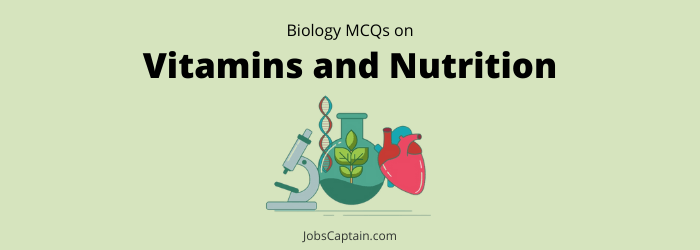
Question 1. The source of Vitamin ‘D’ is_______.
(A) Cashewnut
(B) Orange
(C) Sun rays
(D) Lemon
Question 2. Which of the following is synthesized by intestinal bacteria?
(A) Vitamin B12
(B) Vitamin C
(C) Vitamin K
(D) Both (A) and (C)
Question 3. Which of the following vitamin is used as an antidote to anticoagulant poisons?
(A) Vitamin K
(B) Vitamin E
(C) Vitamin D
(D) Vitamin A
Question 4. Which one of the following vitamins is responsible for blood clotting?
(A) D
(B) E
(C) K
(D) C
Question 5. Which of the following vitamin deficiency causes disease of slow blood coagulation?
(A) Vitamin C
(B) Vitamin K
(C) Vitamin E
(D) Vitamin K
Question 6. Which of the following vitamins does not get stored in the body?
(A) Vitamin E
(B) Vitamin C
(C) Vitamin A
(D) Vitamin B
Question 7. Vitamin ‘C’ helps in absorption of which of following elements?
(A) Sodium
(B) Iodine
(C) Calcium
(D) Iron
Question 8. Which vitamin helps in healing the wound?
(A) Vitamin D
(B) Vitamin C
(C) Vitamin A
(D) Vitamin B
Question 9. The chemical name of Vitamin C is______.
(A) Tartaric acid
(B) Citric acid
(C) Thyamine
(D) Ascorbic acid
Question 10. Which of the following has the highest content of Vitamin C?
(A) Orange
(B) Mango
(C) Guava
(D) Carrot
Question 11. The best source of Vitamin C is_______.
(A) Milk
(B) Gooseberry
(C) Mango
(D) Apple
Question 12. ‘Kanchan’ is an improved variety of_______.
(A) Indian gooseberry
(B) Mango
(C) Guava
(D) Grapes
Question 13. The main source of vitamin ‘C’ is_______.
(A) Pulses
(B) Ghee
(C) Milk
(D) Raw and fresh fruits
Question 14. The vitamin which is found in citrus fruits and is necessary for maintaining healthy skin is_______.
(A) Vitamin D
(B) Vitamin C
(C) Vitamin B
(D) Vitamin A
Question 15. Among the following vegetables, the maximum Vitamin C is found in______.
(A) Radish
(B) Pea
(C) Pumpkin
(D) Chilli
Question 16. Which one of the following vitamins and deficiency diseases is wrongly matched?
(A) Riboflavin – Beri-beri
(B) Cobalamin – Perniciousanaemia
(C) Niacin – Pellagra
(D) Calciferol – Osteomalacia
Question 17. Regular intake of fresh fruits and vegetables is recommended in the diet since they are a good source of antioxidants. How do antioxidants help a person maintain health and promote longevity?
(A) They activate certain genes in the cells of the body and help delay the aging process
(B) They neutralize the free radicals produced in the body during metabolism
(C) They prevent excessive oxidation of carbohydrates, fats and proteins in the body and help avoid unnecessary wastage of energy
(D) They activate the enzymes necessary for vitamin synthesis in the body and help prevent vitamin deficiency
Question 18. Apples have special value for heart patients, because they are rich source of ________.
(A) Potassium only
(B) Potassium and phosphorus
(C) Phosphorus and magnesium
(D) Sodium and potassium
Question 19. In which category of food is the most amount of calories per unit?
(A) Proteins
(B) Carbohydrates
(C) Fats
(D) Vitamins
Question 20. Living organisms require at least 27 elements of which, 15 are metals. Among these, those required in major quantities, include ________.
(A) Sodium, magnesium, copper
(B) Potassium, sodium, magnesium and calcium
(C) Potassium, molybdenum, copper and calcium
(D) Potassium, manganese, molybdenum and calcium
Question 21. Which one of the following is not an essential micronutrient for plants?
(A) Magnesium
(B) Sodium
(C) Potassium
(D) Boron
Question 22. What are vitamins?
(A) Organic compound
(B) Living organism
(C) Inorganic compound
(D) None of the above
Question 23. Funk invented_______.
(A) Enzymes
(B) Proteins
(C) Hormones
(D) Vitamins
Question 24. Which of the following elements is not essential for plant growth?
(A) Magnesium
(B) Calcium
(C) Potassium
(D) Sodium
Question 25. Which one of the following groups of compounds is called ‘accessory dietary factor’?
(A) Vitamins
(B) Proteins
(C) Hormones
(D) Fats
Question 26. The vitamin available from sun rays is_______.
(A) Vitamin D
(B) Vitamin C
(C) Vitamin B
(D) Vitamin A
Question 27. The deficiency of Vitamin D causes the disease_______.
(A) Rickets
(B) Beri-beri
(C) Osteoporosis
(D) Both (A) and (C)
Question 28. Which of the following is found in the composition of Vitamin ‘D’?
(A) Retinol
(B) Folic acid
(C) Calciferol
(D) Ascorbic acid
Question 29. Which of the following vitamins is known as ergocalciferol?
(A) Vitamin B6
(B) Vitamin B12
(C) Vitamin D3
(D) Vitamin D2
Question 30. The common name of the chemical compound ‘Cholecalciferol’ is_______.
(A) Vitamin C
(B) Vitamin B
(C) Vitamin D
(D) Bone Calcium
